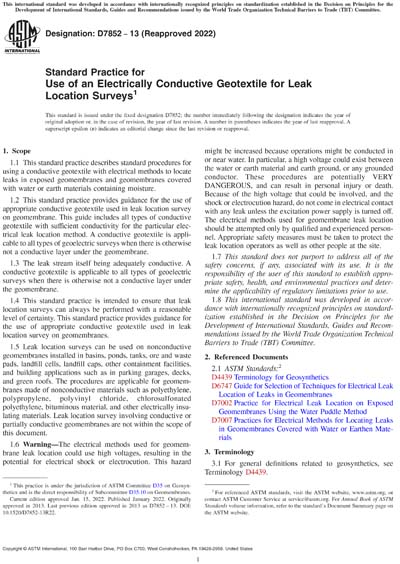Historical
ASTM D7852-13(2022)
Standard Practice for Use of an Electrically Conductive Geotextile for Leak Location Surveys
1.1This standard practice describes standard procedures for using a conductive geotextile with electrical methods to locate leaks in exposed geomembranes and geomembranes covered with water or earth materials containing moisture.
1.2This standard practice provides guidance for the use of appropriate conductive geotextile used in leak location survey on geomembrane. This guide includes all types of conductive geotextile with sufficient conductivity for the particular electrical leak location method. A conductive geotextile is applicable to all types of geoelectric surveys when there is otherwise not a conductive layer under the geomembrane.
1.3The leak stream itself being adequately conductive. A conductive geotextile is applicable to all types of geoelectric surveys when there is otherwise not a conductive layer under the geomembrane.
1.4This standard practice is intended to ensure that leak location surveys can always be performed with a reasonable level of certainty. This standard practice provides guidance for the use of appropriate conductive geotextile used in leak location survey on geomembranes.
1.5Leak location surveys can be used on nonconductive geomembranes installed in basins, ponds, tanks, ore and waste pads, landfill cells, landfill caps, other containment facilities, and building applications such as in parking garages, decks, and green roofs. The procedures are applicable for geomembranes made of nonconductive materials such as polyethylene, polypropylene, polyvinyl chloride, chlorosulfonated polyethylene, bituminous material, and other electrically insulating materials. Leak location survey involving conductive or partially conductive geomembranes are not within the scope of this document.
1.6Warning - The electrical methods used for geomembrane leak location could use high voltages, resulting in the potential for electrical shock or electrocution. This hazard might be increased because operations might be conducted in or near water. In particular, a high voltage could exist between the water or earth material and earth ground, or any grounded conductor. These procedures are potentially VERY DANGEROUS, and can result in personal injury or death. Because of the high voltage that could be involved, and the shock or electrocution hazard, do not come in electrical contact with any leak unless the excitation power supply is turned off. The electrical methods used for geomembrane leak location should be attempted only by qualified and experienced personnel. Appropriate safety measures must be taken to protect the leak location operators as well as other people at the site.
1.7This standard does not purport to address all of the safety concerns, if any, associated with its use. It is the responsibility of the user of this standard to establish appropriate safety, health, and environmental practices and determine the applicability of regulatory limitations prior to use.
1.8This international standard was developed in accordance with internationally recognized principles on standardization established in the Decision on Principles for the Development of International Standards, Guides and Recommendations issued by the World Trade Organization Technical Barriers to Trade (TBT) Committee.
ASTM International [astm]

